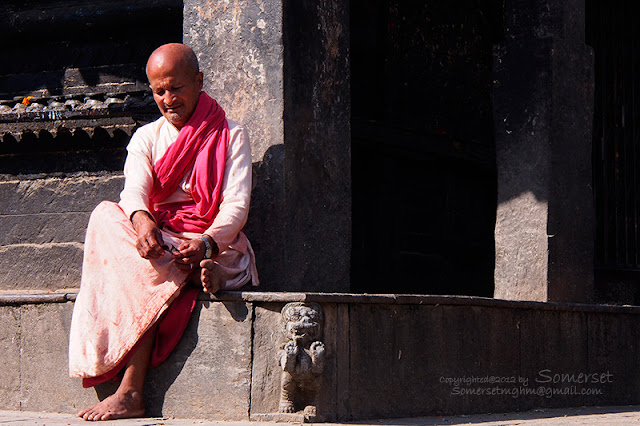Khokana is a village development committee in Lalitpur District in the Bagmati Zone of central Nepal. At the time of the 1991 Nepal census it had a population of 4258 living in 699 individual households.[1]
Khokana, a traditional and tiny Newari village eight kilometers south of Kathmandu (on the outskirts of Patan), which has its own history and has retained its tradition and culture. It is a living museum and recalls medieval times. The farming community of Newars who live here are mostly dependent on agriculture and much of their daily activities take place outside of their dwellings.
There are women sitting outside spinning, men crushing seeds, and other daily activities. The village is famous for its unusual mustard-oil harvesting process in which a heavy wooden beam is used to crush the mustard seeds in order to extract the oil. It is believed that a share system was used in the past here. This oil can be consumed if desired, but it can also be used for therapeutic massage. This was also the first village, indeed the first habitation, to be electrified, before Kathmandu.[citation needed]
In the center is a three-storey temple, Shree Rudrayani, with a particularly wide main street, especially for a village of such small size. Khokana has been nominated to be listed as a Unesco World Heritage, representing a vernacular village and its mustard-oil seed industrial heritage.[2]
"Khokana is a unique village which can be taken as a model of a medieval settlement pattern with a system of drainage and chowks. It houses chaityas and a Mother Goddess temple. The mustard-oil seed industry has become the living heritage of the village."[citation needed]
In January the Khokana festival is held to showcase the unique aspects of the village. Cultural Newari dances, such as the Thimi dance and Devi dance, Newar food, such as Newar pancake (woh), a sweet steamed dumpling filled with molasses and sesame (yomari) and strong Nepali wine (ayla), crafts, music and the towns mustard production were all on display.
From Wikipedia, the free encyclopedia
โกกานาและบุงกะมาตี เป็นหมู่บ้านเล็กๆที่อยู่ติดกัน เป็นหมู่บ้านเก่าแก่ที่สุดแห่งหนึ่งในหุบเขากาฐมาณฑุ สภาพบ้านเรือนและวิถีชุมชมยังเรียบง่ายและยังคงสภาพเก่าแก่ให้เห็นในปัจจุบัน
การเดินทางจากกาฐมาณฑุ มุ่งหน้าลงใต้ผ่านเมืองปาทันเข้าสู่เลเลออกมานอกเมือง จะผ่านทิวทัศน์แบบนาขั้นบันได และทุ่งมัสตาร์ด
จากทางเข้าของหมู่บ้าน เป็นทางเดินบนแผ่นอิฐที่ผ่านบ้านเรือนเรียงรายสองข้างทาง
ด้านในหมู่บ้าน มีทางเดินแคบๆไปสู่ Rato Machhendranath temple ซึ่งในทุกฤดูหนาววัดนี้จะเป็นที่ประดิษฐานของเทพราโตมัจเฉนทรานาถแห่งปาตัน
Rato Machhendranath temple, Bungamati, Kathmandu Valley.
Every year the image of the Rato Machhendranath temple is taken from Bungamati to Jawalakhel in Lalitpur on a chariot. The whole journey takes place during the Rato Machhendranath festival in spring (end of the Nepali year).
รอบๆวัดเป็นบ้านเรือนของชาวบ้านที่ยังคงทำอาชีพกสิกรรมและงานแกะสลักไม้ ช่วงฤดูเก็บเกี่ยวลานวัดจึงกลายเป็นที่ตากข้าวเปลือกของชาวบ้านโดยปริยาย
จากหมู่บ้านบุกะมาตี ขับรถไปอีกนิดเดียวก็จะถึงหมู่บ้านโกกานา (Khokana) หมู่บ้านนี้ได้รับการขึ้นทะเบียนเป็นมรดกโลกทางประวัติศาสตร์และสถาปัตยกรรมที่ควรค่าแก่การอนุรักษ์
This village is also listed in world heritage. This village is mostly popular for its culture and the heritage. People of this village produce pure mustard oil by using traditional method in which they use two heavy beams of wooden block to crush heated mustard seed and extract the oil. They are using this method from many generations.
ชีวิตความเป็นอยู่ ยังเรียบง่าย
The Khokana festival, Nepal, is held every year in August, the day after Gai Jatra. A 5-6 month old goat is thrown in a pond close to Rudrayani temple in Khokana, a village in the south of Kathmandu Valley.
Nine young men enter the pond and start to tear the goat apart by grasping its legs, ears, hoof or tail. The one who manages to kill the goat is the ‘hero’ and leads the Shinkali dance which is held afterwards.
ติดตามอ่านตอนก่อนๆได้ที่นี่
- ปศุปตินาถ - Pashupatinath
- โพธนาถ - Boudanath
- สางขุ,พัชรโยกินี -Sankhu & Bajrayogini Temple
- เมืองโบราณปัตรตาปูร์ - Bhaktapur
- ชางกูรนารายันและนากาก๊อต - Changu Narayan & Nagarkot
- สเวยัมภูนาท - sweyamphunath
- ปาตันหรือลลิตปูร์ - Patan (Lalipur)
- กิรติปูร์ - Kirtipur , Pharping
- หมู่บ้านมรดกโลกบุงกะมาตีและโกกานา - Khokana&Bungkamati











































No comments:
Post a Comment
ผ่านมาแล้วอย่าผ่านเลยไป แวะทักทายกันสักนิด......